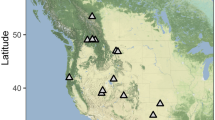Abstract
The ghost bat, Macroderma gigas, and the orange leaf-nosed bat, Rhinonycteris aurantius, occupy similar ranges across northern Australia and are often found in the same roost caves. Both species are considered rare and vulnerable to further population decline. A third small species, the large bent-wing bat, Miniopterus schreibersii, has a similar body mass to R. aurantius, but has one of the largest ranges of any Australian mammal. In the present study we examine the effect and sensitivity of the animals' roosting microclimates on their energy and water balance. M. schreibersii exhibits a basal metabolic rate about 40% greater than other bats of similar body mass, whereas the other two species are close to predicted levels. R. aurantius shows a decrease in body temperatures below thermoneutrality. R. aurantius has levels of pulmocutaneous water loss among the highest seen for a mammal, and calculations based on nasal tip temperatures suggest that most of this loss is across the skin. Calculated ambient temperatures at which metabolic water production is equal to pulmocutaneous water loss in dry air are −14.7 °C for R. aurantius, 9.8 °C for M. schreibersii and −0.3 °C for M. gigas. Exposing the animals to relative humidities of between 80% and 90% shifted these calculated temperatures to 5.6 °C, 25.2 °C, and 2.9 °C, respectively. For each species the ratio of metabolic water production to evaporative water loss has been treated as a joint function of humidity and ambient temperature. The resulting surface plot shows that under known roosting conditions in caves R. aurantius and M. schreibersii remain in positive water balance, whereas M. gigas does not.
Similar content being viewed by others
Author information
Authors and Affiliations
Additional information
Accepted: 20 May 2000
Rights and permissions
About this article
Cite this article
Baudinette, R., Churchill, S., Christian, K. et al. Energy, water balance and the roost microenvironment in three Australian cave-dwelling bats (Microchiroptera). J Comp Physiol B 170, 439–446 (2000). https://doi.org/10.1007/s003600000121
Issue Date:
DOI: https://doi.org/10.1007/s003600000121




